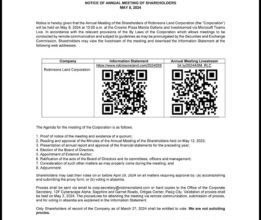External debt service burden soars to P14.7 billion in 2023

THE PHILIPPINES’ external debt service burden skyrocketed to P14.752 billion last year, data from the Bangko Sentral ng Pilipinas (BSP) showed.
Preliminary data from the central bank showed that the country’s debt service burden on its external borrowings surged by 73.9% last year from the P8.483 billion recorded at end-2022.
The debt service burden refers to the amount of money a country needs to pay back its foreign creditors.
As of end-2023, the debt service burden was equivalent to 3.4% of gross domestic product (GDP), higher than the 2.1% ratio as of end-2022.
BSP data showed principal payments climbed by 67.2% to P7.713 billion last year from P4.613 billion as of end-2022.
Interest payments jumped by 81.8% to P7.039 billion last year from P3.871 billion as of end-2022.
Earlier data from the BSP showed that the country’s outstanding external debt hit a record-high $125.4 billion at the end of December. This was higher by 12.7% from $111.3 billion at end-2022 and up by 5.5% from $118.8 billion as of end-September.
The external debt ratio, or share of external debt to GDP, stood at 28.7% in the fourth quarter. This was higher than 28.1% in the third quarter and the 27.5% ratio as of end-2022.
The debt service ratio, or principal and interest payments as a fraction of export receipts and primary income, increased to 10.2% in 2023 from 6.3% in the previous year.
Rizal Commercial Banking Corp. Chief Economist Michael L. Ricafort said that the external debt service burden rose sharply due to higher interest rates.
“Higher inflation also bloated some government expenditures and somewhat led to wider budget deficits than otherwise, all of which also led to higher local and foreign debt servicing bill,” he said in a Viber message.
Inflation averaged 6% in 2023, exceeding the central bank’s 2-4% target range.
The BSP was one of the most aggressive central banks in the region last year, as it raised borrowing costs by a total of 450 basis points (bps) from May 2022 to October 2023 to tame inflation. This brought the benchmark rate to near 17-year high of 6.5%.
“For the coming months, possible Fed rate cuts later in 2024 that could be matched locally could help ease the country’s external and local debt service burden in terms of lower interest expenses on foreign and local debts, going forward,” Mr. Ricafort said. — Luisa Maria Jacinta C. Jocson




